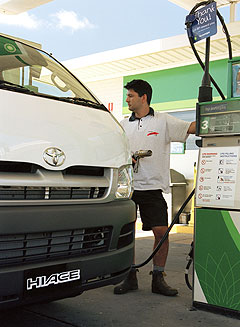Make / Model Search
News - General NewsLPG Autogas industry thinks big for the futureGas it up: LPG's appeal can only increase, says the LPG industry. LPG the key to sustaining Australia's large-car market, says lobby group26 Feb 2010 By PHILIP LORD THE LPG industry expects a six-fold increase in LPG-fuelled vehicles on Australian roads within ten years, due to the fuel's cost and environmental benefits, improved fuelling and on-board storage technology and continuing support from both vehicle manufacturers and the federal government. Speaking in Canberra this week at the announcement of The LPG Industry Report Card 2010, LPG Australia president James Batchen said LPG's increased role in transport within the domestic market was inevitable because of Australia's vast LPG resources. "We are now third in the world in terms of LPG use – 10 years ago we were in first place. My role as president is to get us back to that number-one position again," said Mr Batchen. "But that shouldn’t be difficult because, unlike many of the countries we export to, Australia has a domestic surplus of LPG production, producing something 3.3 million tonnes and using about 58 per cent of that in the domestic market. It’s forecast that by 2020 we’ll be producing more like five billion tonnes. “Currently we think we supply about six per cent of Australia’s transport fuel, but looking at the resource available, we could move to 30 per cent within ten years.” The LPG Industry Report Card, which outlines the current state of the industry - from technology to LPG production - was launched by federal industry minister Kim Carr at Parliament House in Canberra this week.  The LPG industry used the Canberra event to showcase the new liquid LPG injection systems that improve power outputs and fuel efficiency over less sophisticated LPG systems. The LPG industry used the Canberra event to showcase the new liquid LPG injection systems that improve power outputs and fuel efficiency over less sophisticated LPG systems.Mr Batchen believes such technology will drive the popularity of the large-car market, which he said may ultimately only be sustainable with LPG use. “Everybody knows that the big V6 and V8 market has been hammered in the last couple of years and Ford and GM almost went broke because they’re building these large cars that no-one wanted anymore. “The future of the large car is going to be LPG as that’s the only economical way people are going to be able to afford those sorts of vehicles.” Mr Batchen believes the old adage ‘big car for a big country’ still holds true in a continent like Australia. “In Australia it’s still a popular market, it’s a big country with lots of highways to drive down so the V6 family car is still going to be very important – the big issue is, how to make it affordable for them and with LPG I think we can.” Mr Batchen highlighted this point by referring to the popularity of Australia’s only factory-built dedicated-LPG car, the Ford Falcon. “Look at Ford’s numbers – their Falcon range is almost 50 per cent LPG.” Even though the LPG conversion rate is very sensitive to the cost of petrol, Mr Batchen said there were other considerations that could influence the decision to convert to LPG. “What drives people to switch fuels? Sometimes it’s the price of oil, sometimes it might be other family budget considerations - maybe interests rates the family mortgage has gone up, so they have to cut costs somewhere, maybe they can save on fuel costs. I’m not convinced it’s just the oil price that drives people to convert.” Mr Batchen didn’t deny that the LPG industry had some work to do to improve the appeal of LPG. “People are happy and familiar with petrol they need to be spurred on to consider an alternative. And that’s part of what we’re about today... to say ‘okay, LPG is a reasonable alternative’.”  |
Click to shareGeneral News articlesResearch General News Motor industry news |









Facebook Twitter Instagram